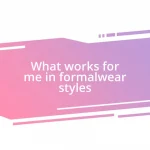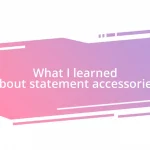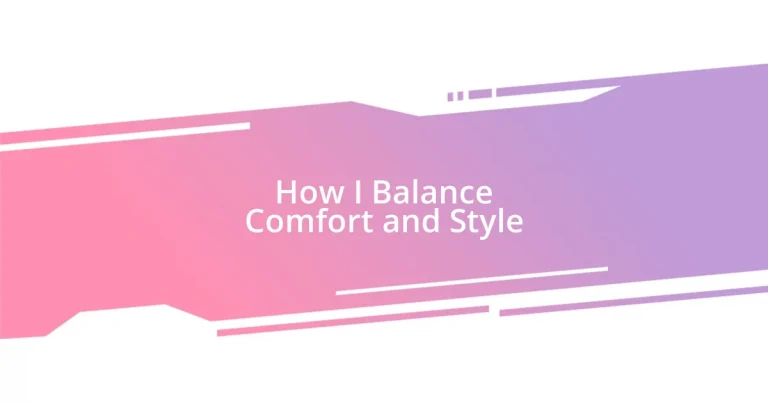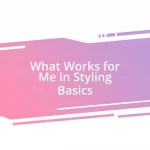Key takeaways:
- Balancing comfort and style is essential in fashion; choosing breathable fabrics, the right fit, and practical designs enhances confidence and everyday wearability.
- Layering, neutral colors, and accessories contribute to versatility in outfits, allowing seamless transitions between different settings and occasions.
- Creating a personal style guide helps individuals define their aesthetic preferences, identify must-have pieces, and shop intentionally to reflect their authentic self.
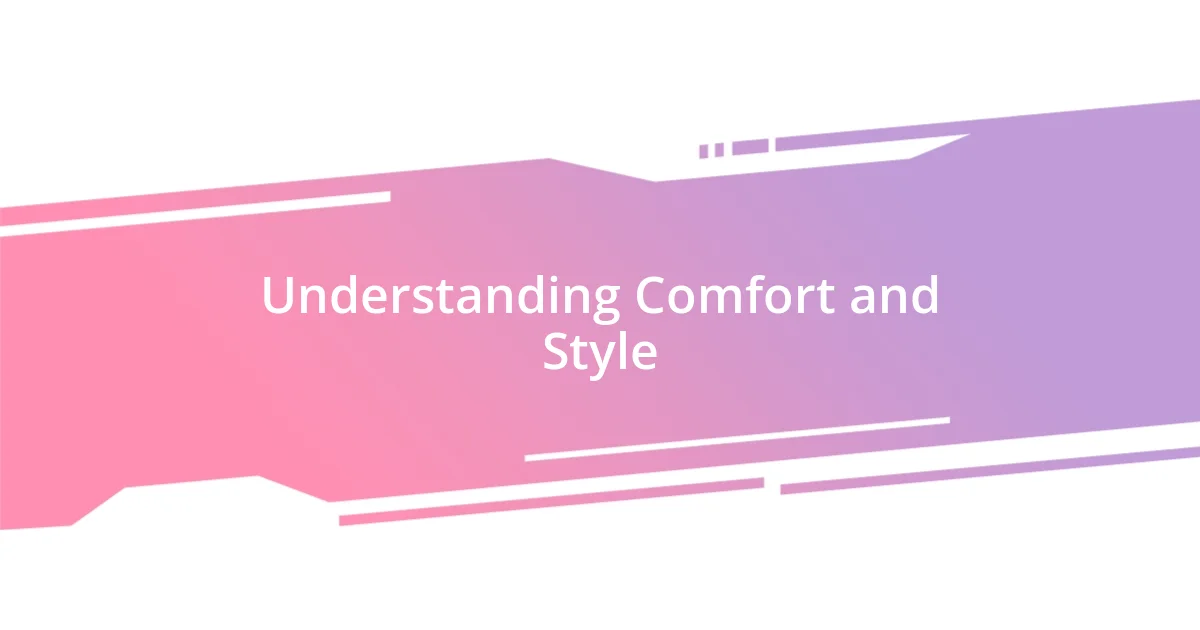
Understanding Comfort and Style
When I think about comfort and style, I often recall my first experience shopping for a pair of shoes. I fell in love with a gorgeous pair of heels, but after a few hours of wearing them, my feet felt like they were on fire. That moment taught me that style shouldn’t come at the cost of comfort; it’s about finding that sweet spot where both can coexist.
Consider how you feel when wearing your favorite outfit. Isn’t there something special about those pieces that make you feel like you can conquer the world? Comfort allows us to be ourselves, while style expresses who we are. Balancing the two is like mastering a recipe; a pinch of comfort and a dash of style can create something truly wonderful.
In my experience, choosing clothing that feels good to wear often enhances my confidence. Think about your go-to outfit; doesn’t it have a special place in your heart? By making thoughtful choices that prioritize comfort and style, I’ve learned that I can look fashionable without sacrificing how I feel.
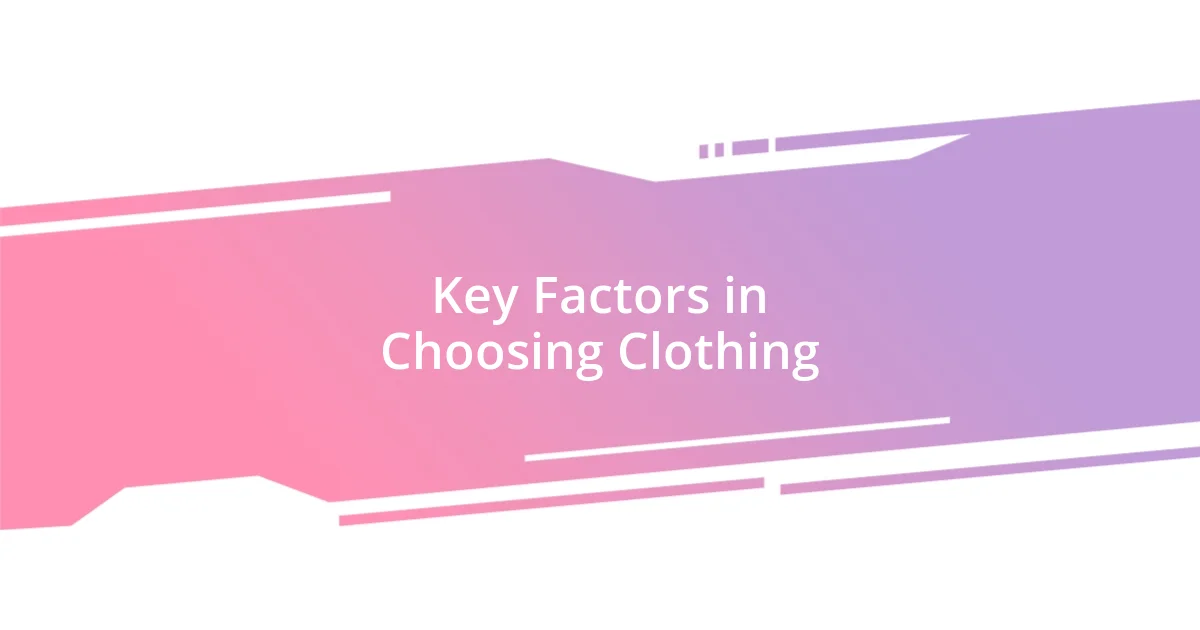
Key Factors in Choosing Clothing
When selecting clothing, it’s vital to consider the fabric. Over the years, I’ve had my fair share of encounters with various materials. I remember purchasing a lovely silk blouse that looked stunning but felt too constrictive for everyday wear. Now, I gravitate toward breathable fabrics like cotton or modal, which offer comfort without compromising on style.
Fit plays an equally significant role in my clothing choices. There was a time when I chose oversized clothing thinking it would give me a relaxed vibe. However, I soon discovered that while it was comfy, it often made me look frumpy. Finding the right fit enhances not only my appearance but also my confidence; a well-fitted garment truly can transform how one feels throughout the day.
Lastly, practicality can’t be overlooked. I fondly think of that time I wore a stylish jumpsuit, only to struggle when it was time to visit the restroom! Balancing convenience with aesthetics is crucial, so I focus on clothing with functional elements, whether it’s pockets or adjustable straps. This way, I can maintain my chic look while ensuring I stay comfortable and hassle-free.
| Factor | Description |
|---|---|
| Fabric | Choose breathable and soft materials for comfort |
| Fit | Select clothing that enhances your natural shape |
| Practicality | Look for functional designs that support your daily activities |
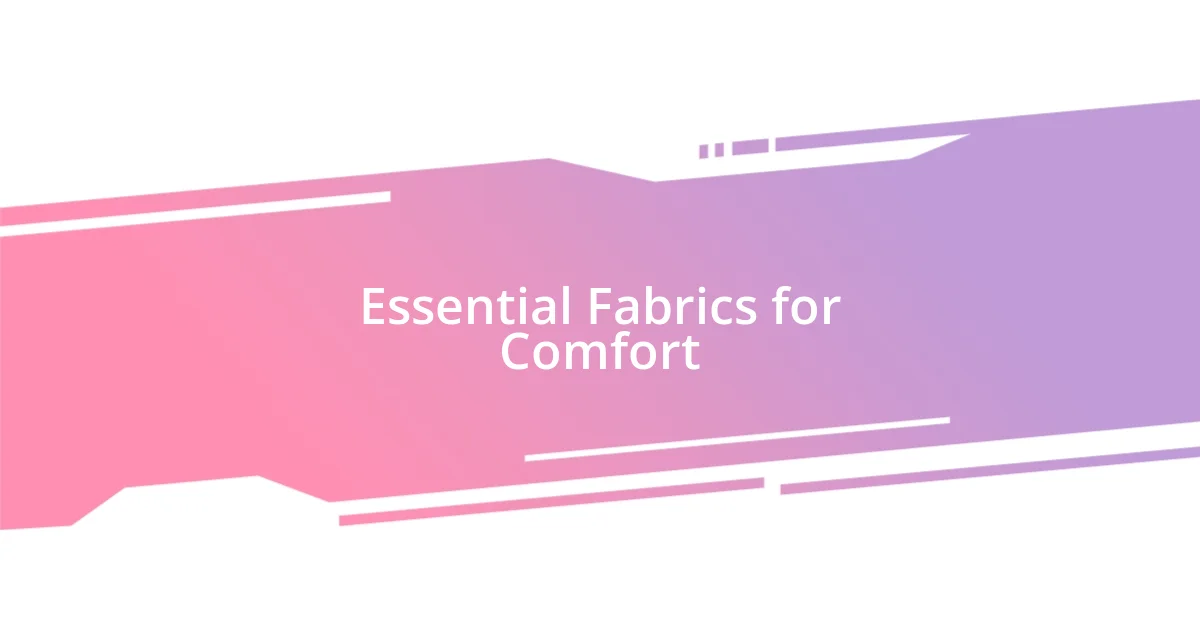
Essential Fabrics for Comfort
Finding the right fabrics is essential for nurturing that perfect blend of comfort and style. I still vividly remember slipping into a cozy cashmere sweater on a chilly evening. Its softness wrapped around me like a warm hug, instantly lifting my spirits. This experience made me realize that investing in quality fabrics can elevate not just our look, but our emotional well-being. Comfort isn’t merely about how something feels against our skin; it influences our mood and confidence throughout the day.
Here’s a quick rundown of some key fabrics that embody comfort:
- Cotton: Breathable and hypoallergenic, making it ideal for everyday wear.
- Modal: Luxuriously soft and drapey, perfect for a stylish and relaxed fit.
- Bamboo: Naturally moisture-wicking and gentle on the skin, plus it’s eco-friendly!
- Linen: Lightweight and crisp, keeping you cool during warmer months.
- Wool: Soft and insulating, great for retaining warmth without bulk.
Through my journey in fashion, I’ve learned that being comfortable in what we wear opens doors to express who we are. Each fabric tells a story, and I believe we should choose those that resonate with our experiences and feelings.
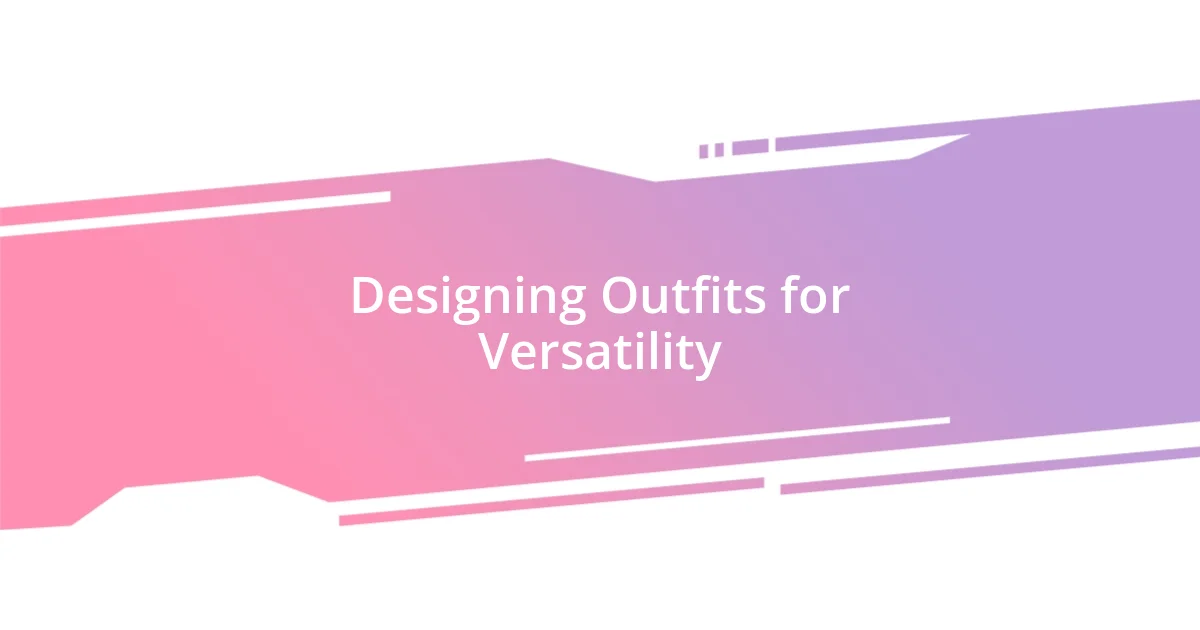
Designing Outfits for Versatility
Designing outfits for versatility means thinking strategically about how different pieces can work together. I find that layering is key; for example, I often start with a simple fitted tee that can be dressed up with a blazer or dressed down with a denim jacket. This flexibility allows me to transition seamlessly from a casual brunch to a business meeting, without breaking a sweat.
Another aspect of versatility is choosing neutral colors or classic patterns. Recently, I invested in a pair of black trousers that I can style with almost anything in my closet. When I wore them for a dinner party, I paired them with a bold top and statement jewelry, but they also looked fantastic with a cozy sweater on a chilly day. Can you think of a piece in your wardrobe that offers that kind of magic?
Finally, incorporating accessories can transform any outfit into something special. I have a few scarves that I love to play with; they can elevate a simple outfit or provide warmth. Each time I step out, I ask myself: how can I mix and match my accessories today to keep things fresh? I find that this playful approach not only enhances my style but also makes getting dressed each morning an enjoyable adventure.
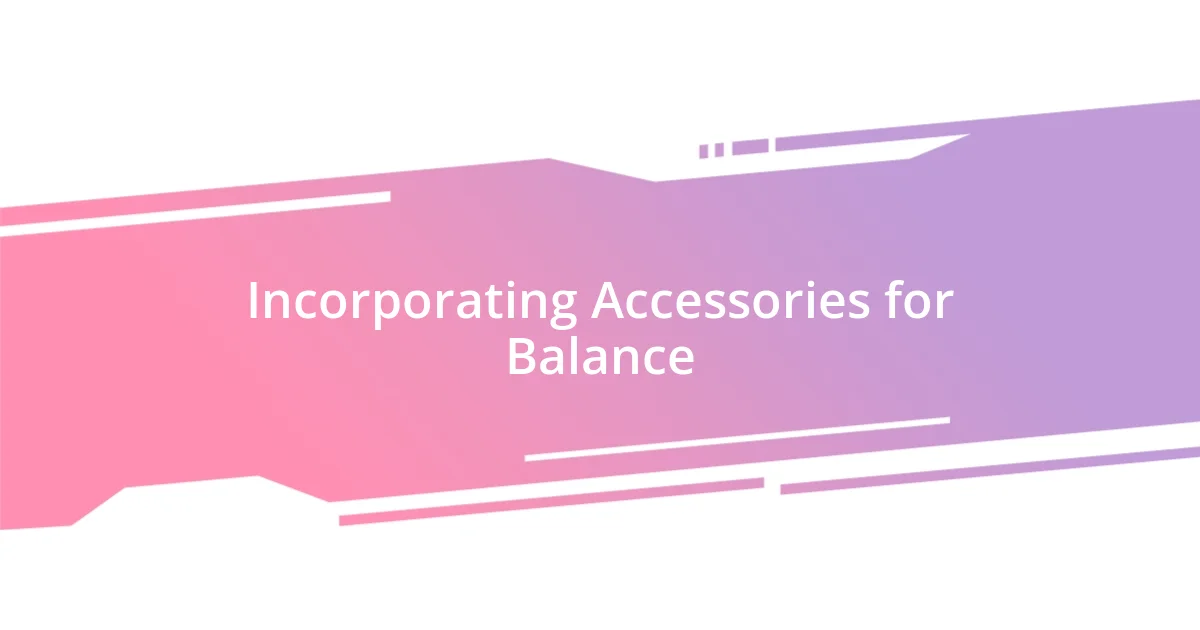
Incorporating Accessories for Balance
I often think of accessories as the final brushstrokes on a canvas, bringing an outfit to life. For example, I have this vibrant pair of earrings that can instantly energize even the simplest ensemble—like my go-to white blouse and jeans. Wearing them feels like a little confidence boost, a reminder that even a small detail can impact how I feel and present myself to the world. Have you ever noticed how a bold accessory can shift your mood for the day?
One of my favorite tricks is to use accessories to balance comfort with a touch of flair. I remember a day when I slipped on my favorite relaxed-fit dress, feeling snug and carefree. I completed the look with a chunky belt and ankle boots, which not only added shape but also introduced a stylish edge. This blend allowed me to feel comfortable enough to lounge at a café while still looking chic.
Another aspect I find interesting is how I can transform the same outfit simply by changing the accessories. I have a leather crossbody bag that I often switch out for a sleek clutch when I’m heading out for the evening. It’s fascinating how these small changes can make a huge difference in how I feel—like my outfit has a new personality. Have you experimented with just swapping out accessories to see how it alters your whole vibe?
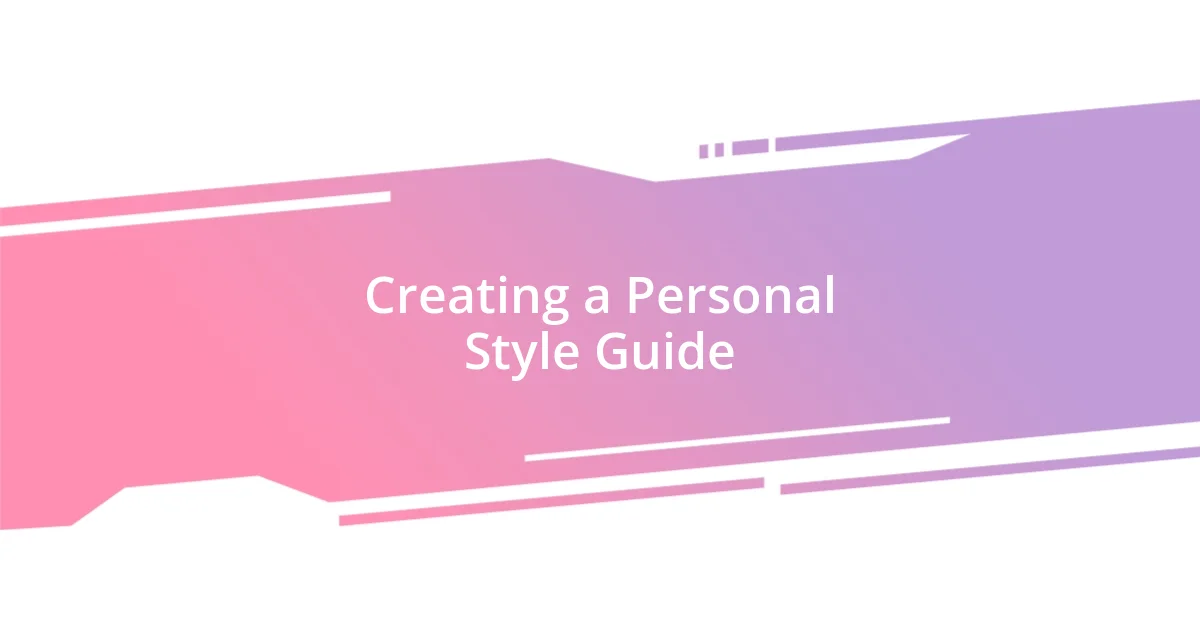
Creating a Personal Style Guide
Creating a personal style guide is all about honing in on what truly resonates with you. I remember when I first started this journey; I dedicated some time to gather inspiration from my favorite fashion icons and create a mood board. It’s surprising how visualizing elements that speak to you can clarify your preferences and lead to that “aha” moment about your own style.
As I built my guide, I found it helpful to include must-have pieces that blend comfort with flair. For instance, I realized that a well-fitted pair of high-waisted jeans became a staple for me. They adapted perfectly to my casual outings with sneakers but could easily be dressed up with heels and a chic blouse for evenings out. What about you? Have you identified those key pieces that make you feel effortlessly stylish yet comfortable?
It also helps to be specific about colors and patterns that resonate with your personality. I, for one, gravitate towards soft earth tones and cozy fabrics. When I wear my favorite olive-green sweater, I feel grounding yet stylish, as if I’m wrapped in comfort while stepping out into the world. By documenting these favorites in my style guide, I can shop more intentionally, avoiding impulse buys that don’t truly reflect my authentic self. What elements would you want to include in your guide to express who you are?


